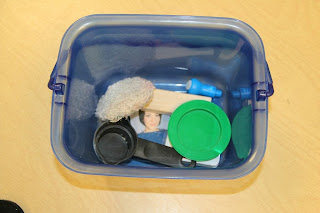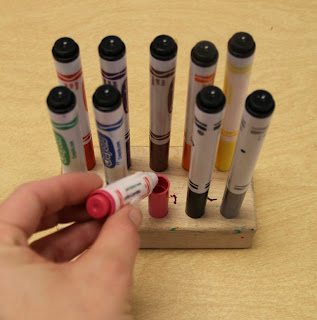An object schedule is a simple way to help children transition. The premise is that the student is given an object that represents the next activity in his/her schedule. This form of scheduling is used when a student is at a very concrete stage of learning.
Here are some examples of object schedules:
Here are some examples of object schedules:
- To prepare the student for a restroom break, provide the child with a pull up.
- To prepare the student for group activity, provide the child with a carpet circle.
- To prepare the student for lunch, provide the child a spoon.
For one of our students last year, we found it helpful to have an object schedule basket specific to her. As often happens at the beginning of a school year, she had a hard time separating from her mom and would cry most of her school day. By having a basket full of only her objects, we were able to visually demonstrate how much work needed to be completed before mom's return.
We taped a picture of her mom and a home icon to the inside of her basket.
We then placed all the objects representing the student's daily activities on top of the photos.
Throughout the day as she completed her activities, she would have fewer objects in her basket. For this student, each object represented an activity location in the classroom. Once she got to that activity, the object from the basket had a designated spot within the activity location. For example, the mini book represented the library center and was placed in a bowl at the library center during that activity.
The marker was used to represent the art center and would be placed in the marker holder during art time.
We taped a picture of her mom and a home icon to the inside of her basket.
We then placed all the objects representing the student's daily activities on top of the photos.
Throughout the day as she completed her activities, she would have fewer objects in her basket. For this student, each object represented an activity location in the classroom. Once she got to that activity, the object from the basket had a designated spot within the activity location. For example, the mini book represented the library center and was placed in a bowl at the library center during that activity.
The marker was used to represent the art center and would be placed in the marker holder during art time.
Within two days of implementing this little twist on a traditional object schedule, the little girl began to cry less and was able to perform and participate more appropriately.
Another trick we used to help with the transition was a watch we adapted to include a picture of mom.
The student wore it everyday to help her understand that mom would be back. During the first week, she cried and shouted "momma" throughout her day. Each time she did this, I would point to my watch and reassure her that momma would return in a little while. After the first week, the student would cry, shout "momma", and then point to her own wrist as if she was communicating and reassuring herself that momma would return. The watch with mom’s photo helped her cope with the transition from home to school.







No comments:
Post a Comment